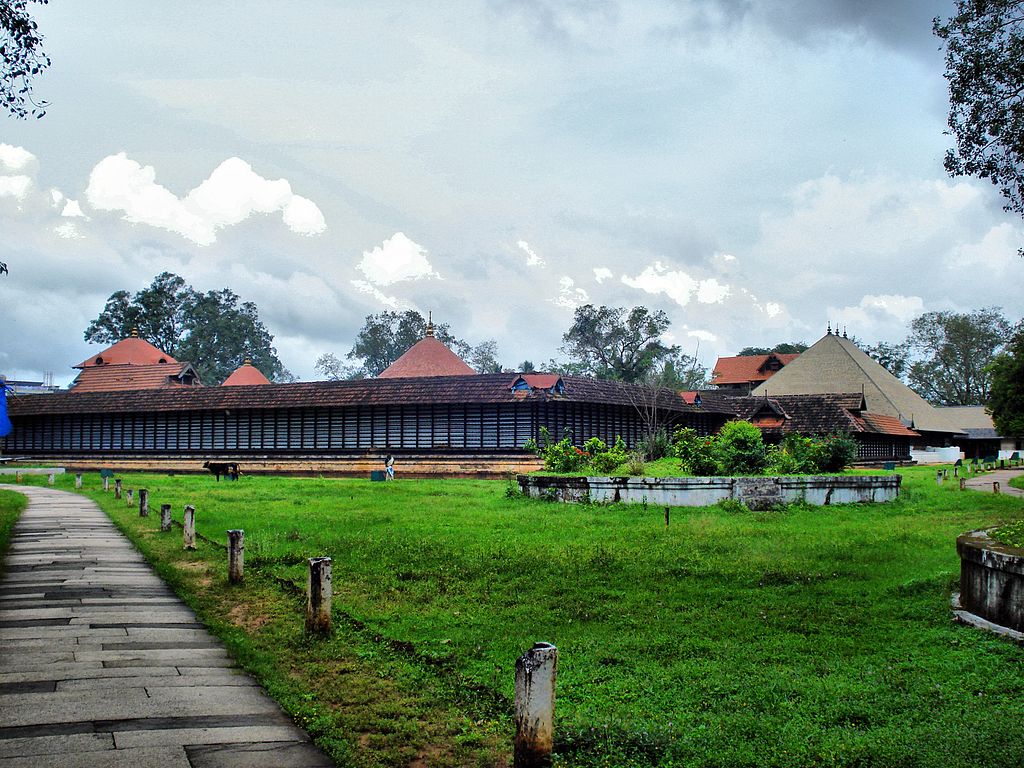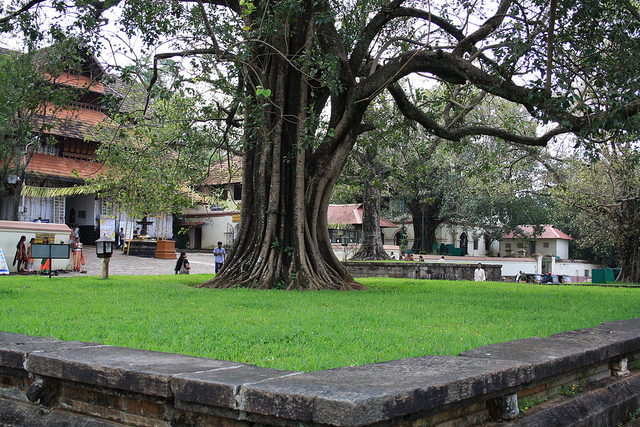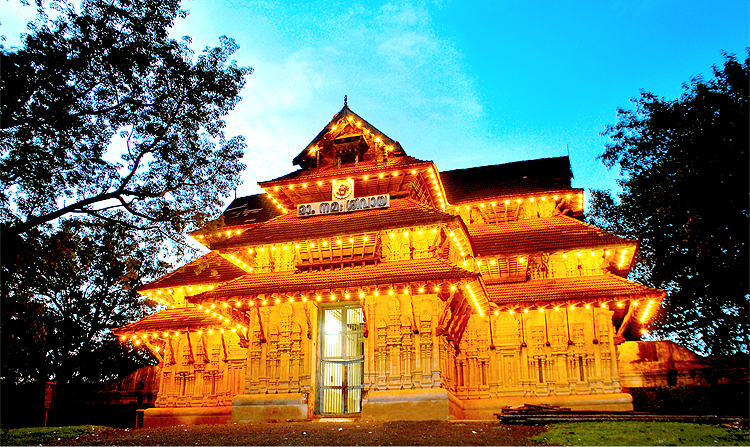Vadakkunnathan Temple
Shiva here is popularly known as Vadakkunnathan (The Lord of the North). His abode is the Kailash in the Himalayas. Since the Himalayas are to the north of India, this name probably refers to that fact.

Vadakkunnathan Temple – the inner temple houses four sanctums dedicated to Lord Shiva, Shankaranarayana, Rama and Ganesh. The outer temple seen in this picture also has several shrines. The temple and its premises cover an area of 9 acres.
According to a very popular legend, this temple was built by Parasurama. He is the 6th incarnation of Lord Vishnu and precedes both Rama (7th incarnation) and Krishna (8th incarnation). Thrissur Pooram is held at the Tekkinkadu Ground (there used to be a teak forest here) around the Vadakkunnathan Temple. Only Hindus can enter the temple. However, non-Hindus can access the Tekkinkadu Ground and participate in Thrissur Pooram.
Legend behind Vadakkunnathan Temple
There is a brief reference to the temple and its origins in Brahmanda Purana and some other religious texts. According to these sources the temple was built by Parashurama (Rama with an axe). He was the son of sage Jamadagni and his pious wife Renuka. He was a Brahmin trained in warfare. Lord Shiva himself taught him for several years and gifted him various celestial weapons. He was the favorite disciple of Shiva.
Parashurama developed extreme hatred for the Kshatriyas (the warrior clan that occupies the position below Brahmins in the social hierarchy) when the mighty Kshatriya king Kartaveerya Arjuna killed his father. To avenge his father, Parashurama exterminated Kshatriyas twenty-one times. At the end of this exercise, he performed a Yagna (a kind of penance) to expiate his sins. He gave away all the land he acquired after killing the Kshatriyas to Brahmins. Now landless, Parashurama wanted to do tapasya (penance) and requested Varuna (the king of oceans) to throw up a piece of land from the sea. Varuna gave him an axe and asked him to hurl it into the sea. Parashurama did so and the sea water receded. The land thus emerged from the sea is Kerala.

Huge banyan tree inside Vadakkunnathan Temple, Thrissur, Kerala – The Shiva linga worshipped at this temple is believed to have emerged from the ground at the foot of a big banyan tree.
This land was not habitable. Parashurama wanted to consecrate it and make it habitable. So he went to Mount Kailash, the abode of Lord Shiva. Parashurama requested Shiva to accompany him to the land he reclaimed from the sea and reside there. Shiva agreed. He, his consort Parvathi and their sons Ganesha and Subrahmanya accompanied Parashurama to Kerala. When they reached Thrissur, Shiva stopped. He and his team suddenly disappeared, and a radiant Shiva Linga emerged from the ground at the foot of a huge banyan tree. This place where Shiva manifested his presence in the form of a linga is the Mula Sthana (original place of worship) of this temple. The linga remained there for quite some time. Later the ruler of Kochi moved it to a more convenient place and built a temple to enclose it.
The Koothambalam (temple theatre) of this temple is believed to have been built by Perumthachan, the famed carpenter who lived in the 7th century. According to some historians this temple was a pre-Dravidian shrine. Over the course of centuries it came under the influence of various religions like Buddhism, Jainism and Vaishnavism. It is possible that at some point it was a Buddhist shrine. Currently it is a Shiva temple where most other Hindu deities are also worshipped. Vadukkunnathan Temple is unlikely to be the oldest temple in Thrissur. Some other temples in this district are older than this temple.
Invasion of Tipu Sultan
Tipu Sultan, the Muslim ruler of Mysore (currently in the state of Karnataka), is widely believed to have destroyed many Hindu temples. Some historians have refuted this theory. According to them the British deliberately spread such stories to create animosity among the Hindus and the Muslims. We don’t know who is right or who is wrong. Anyway, Tipu Sultan didn’t touch Vadakkunnathan Temple. He did halt at Thrissur during his invasion of Kerala, but didn’t attack the temple. Some claim that he was awestruck by its grandeur. He reportedly even donated a large bronze lamp to the temple.
Sakthan Thampuran
Sakthan Thampuran (1751-1805) deserves a special mention here. He was the ruler of Kochi. When he ascended the throne he changed the capital of his kingdom from Thripunithura (near Kochi) to Thrissur. Sakthan Thampuran was a devotee of Vadukkunnathan. He introduced the world famous Thrissur Pooram festival. He cleared the teak forests (thekkinkadu) around the temple and created a spacious ground there. The Pooram is organized here. Sakthan Thampuran has every right to be called the founder of Thrissur. His interest in the temple changed the face and future of Thrissur.

The south gateway (thekke gopura vathil) of Vadakkunnathan Temple illuminated on the occasion of Maha Shivaratri.
Structure
Vadukkunnathan Temple stands on an elevated hillock right in the center of Thrissur city. The temple complex is spread over an area of 9 acres. There is a massive stone wall around the temple and its premises. This wall has four gigantic gopuras (gateways) in all four directions. These gates open to the spacious compound between the outer walls and the inner temple. The public can only enter the temple through the east and west gopuras (gates). The south and north gopuras are not open to the public.
Deities
Lord Shiva (called Vadakkunnathan) is the principal deity. Shiva is worshipped in the form of a huge lingam. An interesting thing is that devotees cannot see this lingam. They will only see a 16 foot mound of ghee accumulated over several centuries. This mound covers the lingam and makes it invisible. Every day, during puja ghee (clarified butter) is poured over the lingam (neyyabishekam). This ghee doesn’t melt even during summer. It doesn’t rot either.
Read about the Amarnath Cave Temple where Shiva is worshipped in the form of an ice lingam.
The outer temple has shrines for Krishna, Nandhi (the celestial bull), Ayyappa, Parashurama, Simhodara, Vettekkaran (Shiva as a hunter) and Adi Shankara. There is a double storied shrine dedicated to Rama in the south. Between these two sanctums stand another double-storied circular shaped sanctum dedicated to Shankaranarayana (the combined form of Shiva and Vishnu). These central shrines have halls in front of them. Ganesha shrine faces the temple kitchen. The offering of appam (cake made of rice and jaggery fried in ghee) is the most important offering at this temple.
Vadukkunnathan Temple also has a museum of wood carvings, ancient wall paintings and antique pieces of art.
Koothambalam
Koothambalam or temple theatre of Vadakkunnathan Temple is world famous for its architectural beauty and craftsmanship. It has four majestic gateways called Gopurams. Ritualistic art forms called Koothu, Koodiyattam and Nangyar Koothu are staged here.
Important Festivals at Vadakkunnathan Temple
Maha Shivaratri
Maha Shivaratri is the main festival of this temple. During this occasion various cultural and musical programs are organized in the temple. About one lakh traditional lamps are lighted as part of the celebrations. The temple dazzling in their brilliance is an unforgettable sight.
Aanayoottu

Aanayuttu at Vadakkunnathan Temple – Elephants are the living manifestations of Lord Ganesh. Many temples in Kerala organize aanayoottu (the feeding of elephants).
Aanayoottu is the feeding of elephants. Elephants are thought to be the living representations of Lord Ganesha. Aanayuttu is celebrated on the first day of the Malayalam month of Karkkidakam. It typically falls in July. A large scale Ashta Dravya Maha Ganapathy Homam is also organized on this day. The elephants aren’t decorated. Thousands of people flock to the temple on this day to feed and worship the elephants. Once every 4 years, Gajapooja (elephant worship) is also conducted at this temple.
Elephants are an integral aspect of the temple festivals of Kerala, but July isn’t festival season. If you are in Kerala during this time and want to see elephants in a religious setting, Vadakkunnathan Aanayoottu is a great opportunity. It is going to be celebrated on July 17, 2016.
Thrissur Pooram
Thrissur Pooram, the most famous and the most colorful of all Poorams, is conducted in the premises of the Vadakkunnathan Temple. However, Vadakkunnathan Temple does not participate in this festival. Vadakkunnathan merely witnesses the festivities and blesses the devotees who throng to the premises of his temple on this day. No special pujas are held at the temple on this day. Idols from the nearby temples are brought to Vadakkunnathan Temple on the Pooram day in grand possessions. They offer their tribute to Lord Shiva (Vadakkunnathan) and leave for their respective temples.
Temple timings
The temple opens daily at 3 am and closes at 10.30 am after morning puja. Pujas are held in the evenings as well and for this the temple reopens at 5 pm and closes at 8.30 pm.